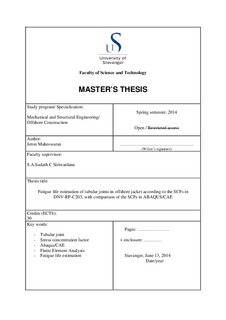| dc.description.abstract | Mostly offshore platform installed in shallow water, less than 300 meters for drilling and production of oil and/or gas are normally fixed to seabed and constructed as truss framework with tubular members as structure elements. The surrounding environment around offshore platform is affected by various environmental loads that comprise of wind, waves, currents and earthquake. The common in these entire loads is the existence of load cycle or repetitive load, which is causing time varying stresses that results too globally and/or locally fatigue damage on the offshore steel structure. This topic has taken great importance for previous and recent design of platform installed offshore. Especially, the area around tubular joint has been highly considered among engineers in their fatigue design. Because several tubular members in fixed platform are usually constructed by weld connection, which give rise to very high stress concentration in the intersection area due to structural discontinuities. A proper design of tubular joints against fatigue failure must therefore be based upon detailed knowledge of the magnitudes of the stress concentration factors (SCF) and the corresponding values of peak stresses (i.e. HSS) at the weld toes of the connections. For such case there are many guideline which covering these topic and suited as guidance to engineers in world offshore industries. DNV-RP-C203 is one typical guideline, which is well used among engineers in oil and gas sector in Norway.
The guideline describes the overall and detail design methodology of fatigue design of offshore steel structure. For fatigue analysis of tubular joints, the guideline covers methodology to determine stress concentration factors, hot spot stresses and finally the fatigue life. The drawback become fact for complex joint and geometry, where joint classification isn’t available and limitation on validity range of non-dimensional geometrical parameter. This is usually solved by finite element software, Abaqus/CAE or similar. For simple uniplanar joint and geometry, where joint classification is available and the limited non-dimensional geometrical parameter in range, the finite element analysis is unpopular to utilize due to the unnecessary time consumption and cost, which is not favourable according to the aspect of business. But still the reliability on the fatigue analysis worked through guidelines equation is still awakening some questions around the accuracy of fatigue analysis of tubular joints.
The purpose of this thesis is to compare the fatigue life of tubular joint in offshore jacket according to the SCFs in DNV-RP-C203 and Abaqus/CAE, with basis on time history analysis carried out in previous master thesis [1] of defined jacket structure in case study [2]. The results reveal that SCFs for particular verified uniplanar tubular joints of proposed FE model and analysis procedure in Abaqus/CAE is close to experimental test results in HSE OTH 354 report [3] under load condition: axial and moment in-plane. While load condition; moment out-of-plane reveal the opposite, but still far away from experimental test results at position saddle and crown on the chord and brace side in the same way as finite element analysis. The same approach was used to analyse tubular joint 9 and 13 (i.e. KT-joint), and the results revealed significant increase in load condition moment out-of-plane and axial, and decrease in load condition moment in-plane compared to parametric equation in DNV-RP-C203 [4]. This has finally brought up remarkable deviation in fatigue life of both tubular joints under comparison of both methods. The conclusion is that more finite element study in Abaqus/CAE [5] is needed to give a definite conclusion between SCFs in DNV-RP-C203 [4] and Abaqus/CAE [5]. | nb_NO |

